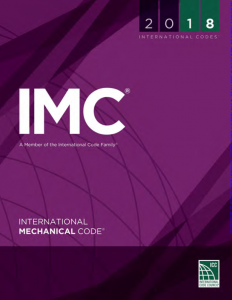Ammonia Refrigeration and the 2018 International Mechanical Code

The International Code Council (ICC) recently released their publication of the 2018 International Mechanical Code (IMC) and it contains three noteworthy changes/clarifications that will impact ammonia refrigeration systems built under the jurisdiction of this code. As we look ahead to 2019, when the IMC will be adopted, it is valuable to be aware of these updates, exceptions, and restrictions:
- References to IIAR Standards
Whereas the 2015 IMC only referenced IIAR 2, the 2018 IMC §1101.6[1] requires ammonia refrigeration systems to comply with IIAR 2, 3, 4, and 5. This means that by direct reference, ammonia refrigeration system design (IIAR 2), valves (IIAR 3), installation (IIAR 4), and start-up/commissioning (IIAR 5) must adhere to IIAR standards.

- Exceptions for Ammonia Detection
2018 IMC §1104.2.2(3)[2] contains exceptions where ammonia detection is not required:
- Unoccupied areas that contain only continuous piping without valves, equipment, or connections;
- Areas that are always occupied;
- Areas that have high humidity or other harsh environmental conditions that are incompatible with detection devices
- Pipe Location Restrictions
2018 IMC §1107.2[3] includes a six-item list of areas where refrigerant piping cannot be installed. Refrigerant piping must not be installed in any of the following locations:
- A fire-resistance-rated exit access corridor.
- An interior exit stairway.
- An interior exit ramp.
- An exit passageway.
- An elevator, dumbwaiter or other shaft containing a moving object.
- A shaft that has one or more openings into a fire-resistance-rated exit access corridor, interior exit stairway or ramp or exit passageway.
[1] 2018 IMC §1101.6 General.
Refrigeration systems shall comply with the requirements of this code and, except as modified by this code, ASHRAE 15. Ammonia-refrigerating systems shall comply with this code and, except as modified by this code, ASHRAE 15, IIAR 2, IIAR 3, IIAR 4 and IIAR 5.
[2] 3. Refrigerant detectors are installed as required for machinery rooms in accordance with Section 1105.3.
Exceptions:
- Refrigerant detectors are not required in unoccupied areas that contain only continuous piping that does not include valves, valve assemblies, equipment, or equipment connections.
- Where approved alternatives are provided, refrigerant detectors for ammonia refrigeration are not required for rooms or areas that are always occupied, and for rooms or areas that have high humidity or other harsh environmental conditions that are incompatible with detection devices.
[3] 2018 IMC §1107.2 Piping location.
Refrigerant piping that crosses an open space that affords passageway in any building shall be not less than 7 feet 3 inches (2210 mm) above the floor unless the piping is located against the ceiling of such space. Refrigerant piping shall not be placed in any of the following:
- A fire-resistance-rated exit access corridor.
- An interior exit stairway.
- An interior exit ramp.
- An exit passageway.
- An elevator, dumbwaiter or other shaft containing a moving object.
- A shaft that has one or more openings into a fire-resistance-rated exit access corridor, interior exit stairway or ramp or exit passageway.

Leave a Reply